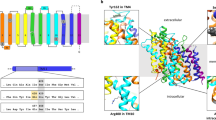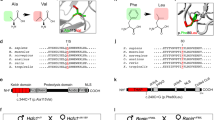Abstract
Holocarboxylase synthetase (HCS) plays an essential role in biotin utilization in eukaryotic cells and its deficiency causes biotin-responsive multiple carboxylase deficiency in humans. We have cloned the human HCS cDNA and show that antiserum against the recombinant protein immunoprecipitates human HCS. A one base deletion resulting in a premature termination and a missense mutation (Leu to Pro) were found in cells from siblings with HCS deficiency. Human HCS shows homology to BirA, which acts as both a biotin-[acetyl-CoA-carboxylase] ligase and a biotin represser in E. coli, suggesting a functional relationship between the two proteins. The human HCS gene maps to chromosome 21q22.1.
This is a preview of subscription content, access via your institution
Access options
Subscribe to this journal
Receive 12 print issues and online access
$209.00 per year
only $17.42 per issue
Buy this article
- Purchase on Springer Link
- Instant access to full article PDF
Prices may be subject to local taxes which are calculated during checkout
Similar content being viewed by others
References
Achuta Murthy, P.M. & Mistry, S.P. Synthesis of biotin-dependent carboxylases from their apoproteins and biotin. J. Scient. Ind. Res. 31, 554–563 (1972).
Wolf, B. & Heard, G.S. Disorders of biotin metabolism in The Metabolic Basis of Inherited Disease (eds Scriver, C. R., Beaudet, A.L., Sly, W.S. & Valle, D.) 2083–2103 (McGraw-Hill, New York, 1989).
Burri, B.J., Sweetman, L. & Nyhan, W. Mutant holocarboxylase synthetase: evidence for the enzyme defect in early infantile biotin-responsive multiple carboxylase deficiency. J. clin. Invest. 68, 1491–1495 (1981).
Feldman, G.L. & Wolf, B. Deficient acetyl CoA carboxylase activity in multiple carboxylase deficiency. Clin. Chim. Acta 111, 147–151 (1981).
Narisawa, K., Arai, N., Igarashi, Y., Satoh, T. & Tada, K. Clinical and biochemical findings on a child with multiple biotin-responsive carboxylase deficiencies. J. inher. metab. Dis. 5, 67–68 (1982).
Packman, S. et al. Acetyl CoA carboxylase in cultured fibroblasts: differential biotin dependence in the two types of biotin-responsive multiple carboxylase deficiency. Am. J. hum. Genet. 36, 80–98 (1984).
Ghneim, H.K. & Bartlett, K. Mechanism of biotin-responsive combined carboxylase deficiency. Lancet 1, 1187–1188 (1982).
Burri, B.J., Sweetman, L. & Nyhan, W.L. Heterogeneity of holocarboxylase synthetase in patients with biotin-responsive multiple carboxylase deficiency. Am. J. hum. Genet. 37, 326–327 (1985).
Bartlett, K. et al. Enzyme studies in combined carboxylase deficiency. Ann. N.Y. Acad. Sci. 447, 235–251 (1985).
Achuta Murthy, P.N. & Mistry, S.P. In vitro synthesis of propionyl-CoA holocarboxylase by a partially purified mitochondrial preparation from biotin-deficient chicken liver. Can. J. Biochem. 52, 800–803 (1974).
Chang, H.I. & Cohen, N.D. Regulation and intracellular localization of the biotin holocarboxylase synthetase of 3T3-L1 cells. Arch. Biochem. Biophys. 226, 237–247 (1983).
Cohen, N.D., Thomas, M. & Stack, M. The subcellular distribution of the holocarboxylase synthetase of rat liver. Ann. N.Y. Acad. Sci. 447, 393–394 (1985).
Chiba, Y., Suzuki, Y., Aoki, Y., Ishida, Y. & Narisawa, K. Purification and properties of bovine liver holocarboxylase synthetase. Arch. Biochem. Biophys. (in the press).
Kozak, M. An analysis of 5′-noncoding sequences from 699 vertebrate messenger RNAs. Nucl. Acids Res. 15, 857–872 (1987).
Lipman, D.J. & Pearson, W.R. Rapid and sensitive protein similarity searches. Science 227, 1435–1441 (1985).
Barker, D.F. & Campbell, A.M. Genetic and biochemical characterization of the birA gene and its product: evidence for a direct role of biotin holoenzyme synthetase in repression of the biotin operon in Eschehchia coli. J. molec. Biol. 146, 469–492 (1981).
Barker, D.F. & Campbell, A.M. The birA gene of Escherichia coli encodes a biotin holoenzyme synthetase. J. molec. Biol. 146, 451–467 (1981).
Buoncristiani, M.R. & Otsuka, A.J. DMA-binding and enzymatic domains of the bifunctional biotin operon represser (BirA) of Escherichia coli. Gene 44, 255–261 (1986).
Eisenberg, M.A., Prahash, O. & Hsiung, S.-C. Purification and properties of the biotin represser. J. biol. Chem. 257, 15167–15173 (1982).
Howard, P.K., Shaw, J. & Otsuka, A.J. Nucleotide sequence of the birA gene encoding the biotin operon represser and biotin holoenzyme synthetase functions of Escherichia coli. Gene 35, 321–331 (1985).
Wierenga, R.K. & Hoi, W.G. Predicted nucleotide-binding properties of p21 protein and its cancer-associated variant. Nature 302, 842–844 (1983).
Kamps, M.P., Taylor, S.S. & Sefton, B.M. Direct evidence that oncogenic tyrosine kinases and cyclic AMP-dependent protein kinase have homologous ATP-binding sites. Nature 310, 589–592 (1984).
Mullins, M.C. & Rubin, G.M. Isolation of temperature-sensitive mutations of the tyrosine kinase receptor sevenless (sev) in Drosophila and their use in determining its time of action. Proc. natn. Acad. Sci. U.S.A. 88, 9387–9391 (1991).
Komatsu, H. & Ikebe, M. Affinity labelling of smooth-muscle myosin light-chain kinase with 5′-[p-(fluorosulphonyl)benzoyl]adenosine. Biochem. J. 296, 53–58 (1993).
Fujimoto Sakata, S., Shelly, L.L., Ruppert, S., Schutz, G. & Chou, J.Y. Cloning and expression of murine S-adenosylmethionine synthetase. J. biol. Chem. 268, 13978–13986 (1993).
Gope, M.L. et al. Molecular cloning of the chicken avidin cDNA. Nucl. Acids Res. 15, 3595–3606 (1987).
Haiti, F.-U., Pfanner, N., Nicholson, D.W. & Neupert, W. Mitochondrial protein import. Biochem. Biophys. Acta. 988, 1–45 (1989).
Surgechov, A.P. Common genes for mitochondrial and cytoplasmic proteins. Trends Biochem. Sci. 12, 335–338 (1987).
Suzuki, T., Yoshida, T. & Tuboi, S. Evidence that liver mitochondrial and cytosolic f umarases are synthesized from one species of mRNA by alternative translational initiation at two in-phase AUG codons. Eur. J. Biochem. 207, 767–772 (1992).
Wilson, K.P., Shewchuk, L.M., Brennan, R.G., Otsuka, A.J. & Matthews, B.W. Escherichia coli biotin holoenzyme synthetase/bio represser crystal structure delineates the biotin- and DMA-binding domains. Proc. natn. Acad. Sci. U.S.A. 89, 9257–9261 (1992).
Chomczynski, P. & Sacchi, N. Single-step method of RNA isolation by acid guanidinium thiocyanate-phenol-chloroform extraction. Anal. Biochem. 162, 156–169 (1987).
Iwamatsu, A. S-Carboxymethylation of proteins transferred onto polyvinylidene difluoride membranes followed by in situ protease digestion and amino acid microsequencing. Electrophoresis 13, 142–147 (1992).
Holton, T.A. & Graham, M.W. A simple and efficient method for direct cloning of PCR products using ddT-tailed vectors. Nucl. Acids Res. 19, 1156 (1991).
Sambrook, J., Fritsch, E.F. & Maniatis, T. Molecular cloning: a laboratory manual (Cold Spring Harbor Laboratory, New York, 1989).
Laemmli, U.K. Cleavage of structural proteins during the assembly of the head of bacteriophage T4. Nature 227, 680–685 (1970).
Hariow, E. & Lane, D. Antibodies: a laboratory manual (Cold Spring Harbor Laboratory, New York, 1988).
Saunders, M.E., Sherwood, W.G., Duthie, M., Surh, L. & Gravel, R.A. Evidence for a defect of holocarboxylase synthetase activity in cultured lymphoblasts from a patient with biotin-responsive multiple carboxylase deficiency. Am. J. hum. Genet. 34, 590–601 (1982).
Yoshiura, K. et al. Mapping of the bone morphogenetic protein 1 gene (BMP1) to 8p21: removal of BMP1 from candidacy for the bone disorder in Langer-Giedion syndrome. Cytogenet. Cell Genet. 64, 208–809 (1993).
Author information
Authors and Affiliations
Rights and permissions
About this article
Cite this article
Suzuki, Y., Aoki, Y., Ishida, Y. et al. Isolation and characterization of mutations in the human holocarboxylase synthetase cDNA. Nat Genet 8, 122–128 (1994). https://doi.org/10.1038/ng1094-122
Received:
Accepted:
Issue Date:
DOI: https://doi.org/10.1038/ng1094-122
This article is cited by
-
Transcriptome-wide N 6 -methyladenosine methylome profiling of porcine muscle and adipose tissues reveals a potential mechanism for transcriptional regulation and differential methylation pattern
BMC Genomics (2017)
-
Effects of single-nucleotide polymorphisms in the human holocarboxylase synthetase gene on enzyme catalysis
European Journal of Human Genetics (2012)
-
Positive newborn screen in the biochemically normal infant of a mother with treated holocarboxylase synthetase deficiency
Journal of Inherited Metabolic Disease (2009)
-
Carnitine transporter and holocarboxylase synthetase deficiencies in The Faroe Islands
Journal of Inherited Metabolic Disease (2007)



